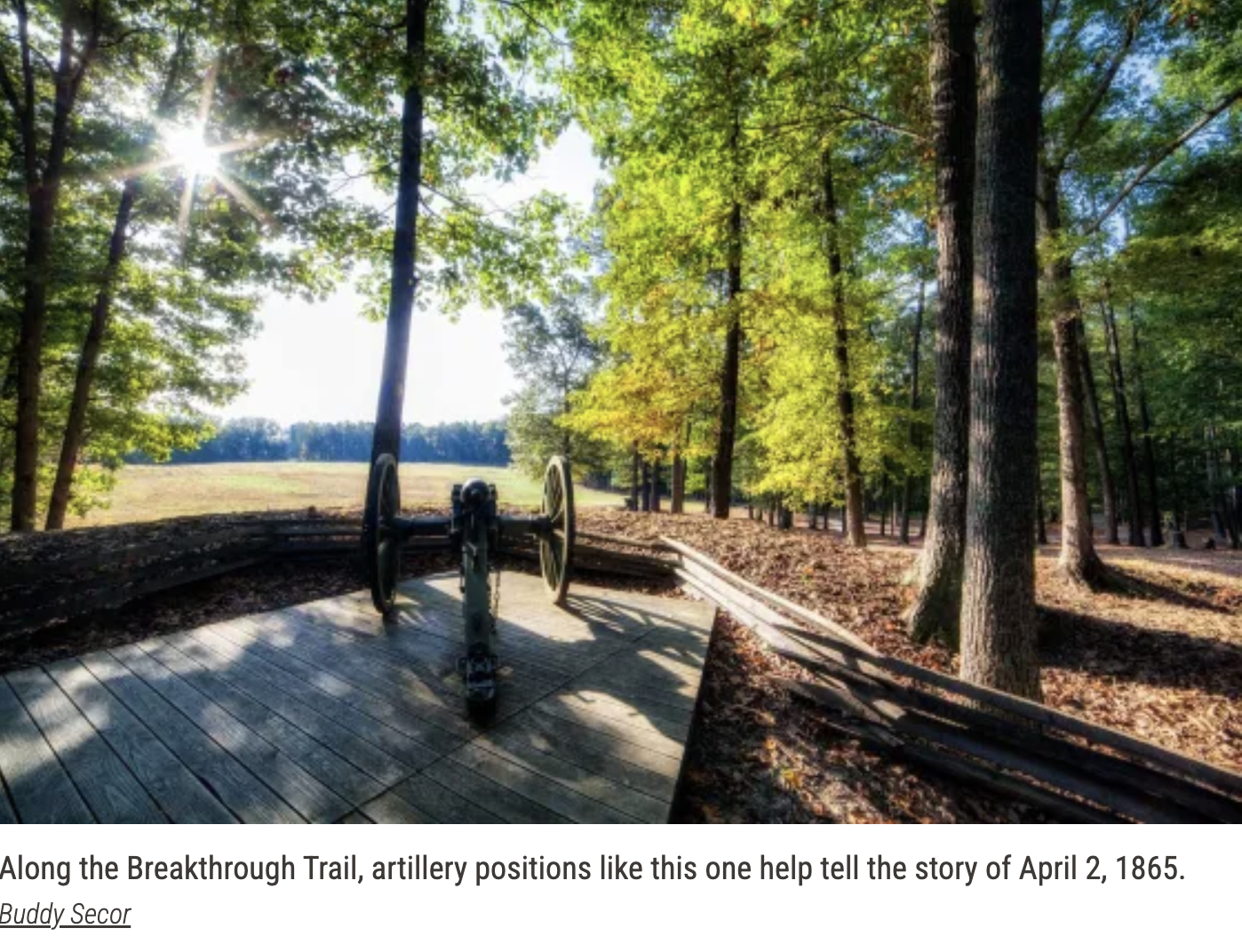Trust will acquire and conserve the 417-acre Pamplin Park campus and its historic features, and allow for the continued, long-term operation of the popular museum and living history classroom
Mary Koik or Jim Campi (202) 367-1861, Option 3 or news@battlefields.org
Amanda Jones, AJones@pamplinpark.org
July 16, 2025
(Petersburg, Va.) — The American Battlefield Trust is embarking on one of the largest preservation projects in its history, a national fundraising campaign that will result in an 857-acre protected swath of land associated with one of the Civil War’s most significant battlefields. The 417 acres currently owned by Pamplin Historical Park and Museum of the Civil War Soldier have been enjoyed and appreciated for decades by heritage tourists and countless school students, but until now has not been fully protected for future generations.
The Trust has agreed to acquire the property for $11 million. Thanks to anticipated matching grant funding from the federal American Battlefield Protection Program, which has helped protect approximately 35,000 acres of hallowed ground across 20 states, and a major landowner donation, the Trust is seeking to raise $660,000 by year-end to complete the transaction. Learn more at www.battlefields.org/breakthrough.
“There is no denying that this is an ambitious undertaking,” said American Battlefield Trust President David Duncan, “We begin the endeavor with the conviction that our members will rise to the occasion and the certainty that future generations will be enriched by the permanent protection of this incredible landscape.”
“This process will not only secure the battlefield for all time, but proceeds from the sale will create an investment fund that will finance the new Breakthrough Battlefield Foundation and enable Pamplin to continue operations in perpetuity,” said Colin Romanick, executive director of Pamplin Historical Park & The National Museum of the Civil War Soldier.
Following a nine-month siege, the Union Army of the Potomac launched a massive assault on the Southern defenses southwest of Petersburg, Va., on April 2, 1865, an attack remembered by history as “The Breakthrough” for breaking those lines clearing the road to the Confederate capital at Richmond. Within weeks, the Civil War was over.
Through a series of transactions over the course of 30 years, the Trust has acquired 439 acres associated with the Union advance and gradually restored them to their wartime appearance by removing modern buildings and other intrusions. Meanwhile, the contiguous Pamplin campus occupies a significant section of the Confederate line and includes two miles of pristine earthworks. Acquisition by the Trust and establishment of a long-term agreement with the newly formed Breakthrough Battlefield Foundation will play to both entities’ strengths: historic landscape preservation and immersive educational experiences, respectively. It will also create improved interpretive and recreational opportunities by unifying trail systems.
The campus was assembled in phases through purchases made by businessman and philanthropist Dr. Robert B. Pamplin, Jr., beginning in the early 1990s when the Association for the Preservation of Civil War Sites, a predecessor of the American Battlefield Trust, alerted him of a development threat to land once owned by his family. Pamplin went on to acquire adjacent parcels, including Tudor Hall, the plantation home of his ancestors, and Banks House, Ulysses S. Grant’s headquarters on April 2-3, 1865. The 25,000 square-foot National Museum of the Civil War Soldier opened on Memorial Day 1999 and the park was named a National Historic Landmark in 2006.
“I'm absolutely delighted that the Trust and Pamplin Historical Park have combined to ensure that this important educational facility will be preserved forever and continue to inspire tens of thousands of visitors each year,” said A. Wilson Greene, a founder of the Trust’s predecessor organization who went on to serve as the executive director of Pamplin Park from its opening until his retirement in 2017.
Captain Charles G. Gould of the 5th Vermont Veteran Volunteers leads his men into the earthworks defended by the 37th North Carolina at Petersburg on April 2, 1865. Don Troiani
Fighting at The Breakthrough was intense — sometimes hand-to-hand — and climactic, resulting in perhaps the greatest concentration of Medals of Honor ever awarded. Researchers at the Congressional Medal of Honor Society believe that 31 Medal citation actions occurred across the now-combined site, which also witnessed subsequent assaults on Fort Gregg and Fort Whitworth and further medals.
“This battlefield is where courage met consequence,” said Congressional Medal of Honor Society President Britt Slabinski, who received the Medal during the Global War on Terrorism, Afghanistan. “The men who fought here embodied duty: in the dirt, under fire, when everything was on the line. This ground speaks plainly about what courage truly looks like. By preserving it, we give future generations the chance to stand where they stood, carry the weight they bore, and grasp the true cost of service. This is how we honor them — not just with words, but by protecting the very place where their legacy was forged.”
To learn more about the fighting at the Breakthrough or make a gift to this remarkable opportunity to ensure this hallowed ground is protected forever, visit www.battlefields.org/breakthrough.

